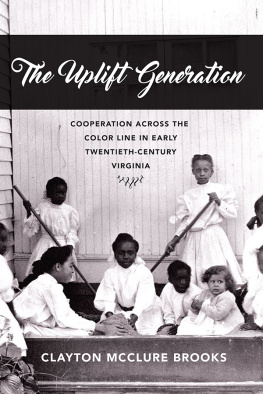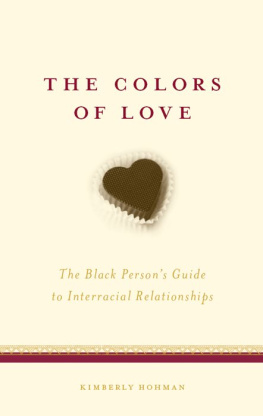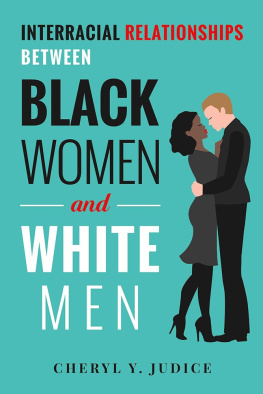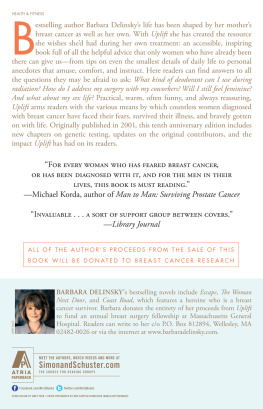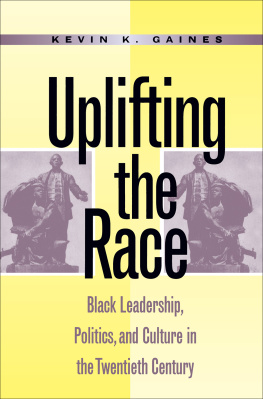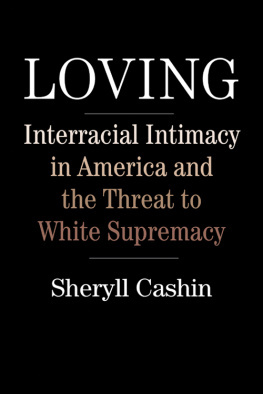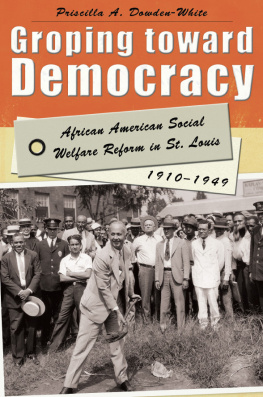THE AMERICAN SOUTH SERIES
Elizabeth R. Varon and Orville Vernon Burton
EDITORS

University of Virginia Press
2017 by the Rector and Visitors of the University of Virginia
All rights reserved
Printed in the United States of America on acid-free paper
First published 2017
1 3 5 7 9 8 6 4 2
Library of Congress Cataloging-in-Publication Data
Names: Brooks, Clayton McClure, author.
Title: The uplift generation : cooperation across the color line in early twentieth-century Virginia / Clayton McClure Brooks.
Other titles: American South series.
Description : Charlottesville ; London : University of Virginia Press, 2017 |
Series: American South series | Includes bibliographical references and index.
Identifiers: LCCN 2016032563 | ISBN 9780813939490 (cloth : alk. paper) |
ISBN 9780813939506 (e-book)
Subjects: LCSH: VirginiaRace relationsHistory20th century. | Virginia
History20th century. | VirginiaSocial conditions20th century.
Classification: LCC F231 .B85 2017 | DDC 975.5 / 043dc23
LC record available at https://lccn.loc.gov/2016032563
Cover art: Children playing in a sandbox at Janie Barretts Locust Street Settlement in Hampton, Virginia, in 1903. (Courtesy of Harvard Art Museums/Fogg Museum, Transfer from the Carpenter Center for the Visual Arts, Social Museum Collection, 3.2002.232.3)
For Thomas, William, Nora, and Olivia.
You are my world an often loud, messy, and crazy world, but my world.
ILLUSTRATIONS
ACKNOWLEDGMENTS
T HIS PROJECT HAS been one that has grown, changed, and expanded over many years, dating back to my graduate school days at the University of Virginia. The road to finishing and publication has been slow, through research, teaching, pursuing alternative research projects, and family, especially raising three fantastic and rambunctious children. However, I do not think the end product could have been possible without these diversions, as all helped to inspire new insights.
I have so many people to thank for their help over the years. My undergraduate years at Roanoke College and the wonderful faculty there helped instill in me a love of history. In graduate school, I was encouraged by a number of wonderful professors, especially Ed Ayers, Cindy Aron, and Grace Hale. Grace Hale, in particular, was a wonderfully dedicated adviser who helped push me in my research and learning, and whose example continues to shape how I work with my own students today.
During my postdoctoral fellowship at the Woodrow Wilson Presidential Library, I had the opportunity to revisit some my old research, in addition to a book I was working on for the National Governors Association. It was then that my ideas for the current volume took shape. I want to thank Ethan Sribnick for his advice in rethinking my project.
Since the fall of 2012, I have been teaching at Mary Baldwin University, and I am grateful to both my colleagues and students there for their support. I love teaching because it encourages a constant process of learning, and every day I learn from my students. Although research is the key to any new project, I found that through teaching I gained the perspective to rethink my earlier conclusions.
Throughout the research phase of my project, I relied on a number of libraries and archives whose staffs were all welcoming and supportive. I particularly want to thank those at the Library of Virginia, the Albert and Shirley Small Special Collections Library at the University of Virginia, the Virginia Historical Society, and the Perkins Library at Duke University. For their assistance in preparing illustrations for my manuscript, I am also very appreciative of the Hampton Museum, the Maggie Lena Walker Historical Site, the Special Collections Library at Virginia Tech, and Harvard University.
One of my earliest ventures in this line of research came through an article I wrote for Women Shaping the South: Creating and Confronting Change, published by the University of Missouri Press in 2006. My thanks to the editors of that book, Judith McArthur and Angela Boswell, for their help in pushing me to refine my argument and writing. I also thank Graham Dozier for his help with an article about Mary Johnston I published in the Virginia Magazine of History and Biography in December 2014.
This book would not have been possible without the support that I received from the University of Virginia Press. In particular, Richard Holway has been supportive of my research for a number of years and has been of tremendous help in refining and shaping my project. I am also grateful to Anna Kariel and Morgan Myers for their invaluable help in seeing this book to publication.
I want to thank my sisters, my friends, and all my family for their support. My mother, Lois McClure, has always been my biggest supporter and willing to read any draft I send her way. Although I lost my father far too early to lung cancer, his memory continues to influence me every day, especially in his exuberance for life and drive to work hard for what you love. This project could not have been possible without the support of my husband, Thomas Brooks, who has encouraged me through thick and thin. And, finally, I want to thank my three spirited children, William, Nora, and Olivia, who tried to be patient during the many hours I spent writing and who, always, kept me entertained.
INTRODUCTION

The Uplift Generation
Efforts to better race relations make more palatable the various species of injustice dealt out to the Negro in America, and particularly in the South, by the dominant white race.
John Mitchell Jr., 1932
W HEN THE ARTIST and lifelong activist Adele Clark sat down for an interview in 1964 at the age of eighty-two, she reminisced about the high and low points of her activism, especially for womans suffrage. Clark was born in Montgomery, Alabama, on September 27, 1882, and moved around the South in her childhood, yet she spent most of her life in Richmond, Virginia. Although not from the wealthiest or most well-connected family, Clark enjoyed the advantages of an upper-class white Virginian. Her true love was art, and she devoted her life to not only her own art but promoting the arts in Richmond. Reflecting back on her life, Clark viewed her suffrage activism with the hindsight afforded by many years. Perhaps as a result of the civil rights movement unfolding around her, she expressed regret that she and her white peers had not worked to more fully include black women in their suffrage crusade. Yet, her memories also revealed true moments of interracial activism now nearly forgotten by history.
After the Nineteenth Amendment was finally ratified in the summer of 1920, a number of white Virginians feared that a potential surge of black female voters would rock the balance of white supremacy in the state. Registrars attempted all sorts of creative roundabout tactics to keep black women from registering, and some white newspapers resorted to fear-mongering editorials. Rather than ignore or feed into these tactics, a number of white members of the Equal Suffrage League worked together to protest these actions and demand fairer registering procedures.
Adele Clark, however, and her longtime friend and companion, Nora Houston, decided further action was needed to ensure the polls would not erupt into violence on Election Day. Thus, these women arranged a meeting one evening
Next page
